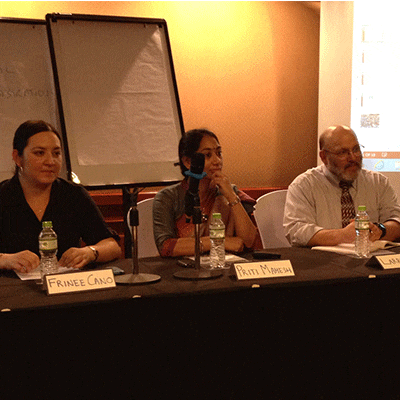L arry King, a legislative analyst on Sims Recycling Solutions’ OEM Compliance team, was an invited speaker at the 4th annual International E-Waste Management Network (IEMN) meeting in Hanoi, Vietnam in July. The meeting was sponsored by the U.S. Environmental Protection Agency (EPA), the EPA Taiwan, and the Vietnam Environment Administration. IEMN enables environmental officials from around the world to exchange information and best practices on e-waste management. IEMN invites outside experts to share their knowledge with attendees to help facilitate this exchange. This year’s conference was attended by approximately 30 people, representing 16 countries from around the world.
arry King, a legislative analyst on Sims Recycling Solutions’ OEM Compliance team, was an invited speaker at the 4th annual International E-Waste Management Network (IEMN) meeting in Hanoi, Vietnam in July. The meeting was sponsored by the U.S. Environmental Protection Agency (EPA), the EPA Taiwan, and the Vietnam Environment Administration. IEMN enables environmental officials from around the world to exchange information and best practices on e-waste management. IEMN invites outside experts to share their knowledge with attendees to help facilitate this exchange. This year’s conference was attended by approximately 30 people, representing 16 countries from around the world.
The title of the session King participated in was “The Future of Cathode Ray Tube (CRT) Recycling.” In addition to King, the panel included Frinee Cano from the Ministry of the Environment Mexico and Priti Mahesh from Toxics Link, an NGO based in India. The panel was moderated by Dr. Shunichi Honda of the Ministry of Environment Japan.
King spoke about Sims’ experience with collecting and processing material for manufacturers affected by U.S. electronics take back laws and the difficulty of managing CRT’s under the non-hazardous exemption as defined in the Resource Conservation and Recovery Act (RCRA). Unfortunately, technology and the marketplace have moved forward but the exemption criterion has not. In order to receive the exemption, the material must go to a lead smelter or a glass-to-glass processor. There were multiple CRT glass manufacturers in the U.S. when the exemption was written, but now there is currently only one left in the world and the demand for new CRTs has lessened. There are also limited options for smelting the glass for lead and the lack of capacity and distances necessary to transport material to a smelter make this second option financially unfeasible.
India currently has the only CRT manufacturer left that will accept CRT cullet. However, according to Mahesh the market for CRTs in India is effectively non-existent. “Most of the CRTs from across the globe are being shipped to India where recycling is done in an improper manner, resulting in occupational risks and environmental damage,” said Mahesh. The typical processing method for CRTs in India is to break the tube with a hammer and remove the metal band. The CRT glass is being mixed with other recyclable glass which contaminates all of the material. The informal sector is very large in India and the lack of knowledge on the proper management of the material is contributing to the contamination. This cross contamination is becoming a big issue in that the glass can end up in children’s toys (marbles) and bakery equipment (ceramic baking stones). At this point, the government of India does not see CRTs as a problem; however this could be due to the fact that there are so many other environmental issues in India that must be addressed.
Cano’s department at the Ministry of the Environment Mexico mostly conducts research. Specifically, she has been researching the leaching issue with tiles made with glass from CRTs. To date there have been no findings of leaching from the tiles which is good news because this research will help develop other uses for CRT glass cullet and possibly take the pressure off smelters as the only available outlet for CRT glass other than the landfill.
All of the presentations were well received and there were numerous questions raised by the audience. Clearly, the CRT issue touches every country and all are struggling to properly manage the material. It was also clear that no single segment (government, NGO, recycler, or manufacturer) will solve the problem. Each segment will need to work with others to find a solution that meets environmental, economic and social needs.
Visit the IEMN Network for more information on the meeting and presentations. For more information on Sims’ North American and international activities email us at [email protected].
To view the most recent OEM Compliance News, click here.
